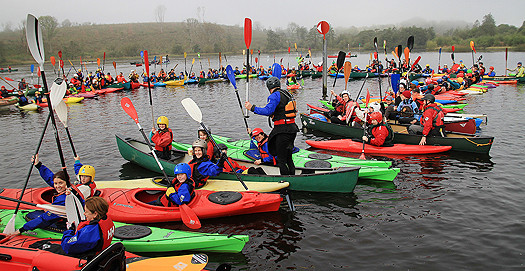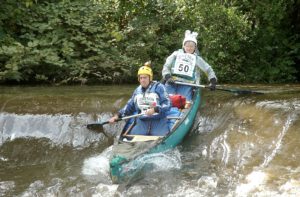What is Open Canoe/Boating:
A canoe is a lightweight narrow vessel, typically pointed at both ends and open on top, propelled by one or more seated or kneeling paddlers facing the direction of travel using a single-bladed paddle.[1] In International Canoe Federation nomenclature used in some European countries such as the United Kingdom the term canoe refers to kayaks,[2] while canoes are called Canadian canoes.
Canoes are professionally used for transport of people and materials all over the world. Besides canoes are widely used for pleasure racing, whitewater canoeing, touring and camping, freestyle, and general recreation. The intended use of the canoe dictates its hull shape and length and construction material.
Historically, canoes were dugouts or made of bark on a wood frame,[3] but construction materials evolved to canvas on a wood frame, then to aluminum. Most modern canoes are made of molded plastic or composites such as fiberglass. Until the mid-1800s the canoe was an important means of transport for exploration and trade, but then transitioned to recreational or sporting use. However, in some places, canoes are still used locally for their historical purpose. Canoeing has been part of the Olympics since 1936. In places where the canoe played a key role in history, such as the northern United States, Canada, and New Zealand, the canoe remains an important theme in popular culture.
Canoes can be adapted to many purposes, for example with the addition of sails, outboard motors, and outriggers.
Where can you do it:
Canoeing can be done all over Ireland. Many providers run ‘learn to canoe and kayak courses which is the minimum skill level needed to join most clubs in Ireland. Alternatively some clubs run their own learn to Canoe/Kayak courses too. To find out more, why not check out our map on our website to find out more about clubs that are close to you. You can do just that by clicking here.
What do you need for it:
You will need the following items of clothing:
- Wetsuit/Drysuit
- ISO Approved Helmet
- ISO Approved Buoyancy Aid
- Spraydeck
- hardsoled shoes
As with every sport, the equipment needed will vary depending on what level of skill you’re at so it’s always a good idea to have a chat with your club members or instructor about what gear would be best suited for you.
What are the conditions for kayaking on the rivers, lakes and canals:
As with every sport, the equipment needed will vary depending on what level of skill you are at so it’s always a good idea to have a chat with your club members or instructor about what gear would be best suited for you.
Beaufort scale
The Beaufort scale is a scale of 1 to 12 which measures the speed of wind and how that affects the sea/lakes with 1 being a glassy flat sea/lake to 12 being hold on to your hat hurricane weather with extremely rough seas/lakes. There are many websites which provide in depth explanations of the scale but we have found a few useful links for you;
- http://www.kayarchy.com/html/03thesea/003wind.htm
- http://www.ukseakayakguidebook.co.uk/understanding_forecasts/beaufort_scale.htm
- https://www.met.ie/climate/wind.asp
What weather conditions do I need to be aware of when sea kayaking and where do I find this information?
Important weather conditions you need to be aware of while canoeing are wind speeds, wind direction, wave height/direction and tides.
There are many ways of gauging what the conditions will be like on your adventure, below are some helpful links to websites we like to use before getting out on the water.
Met.ie – National forecast and Rainfall radar
Ballooningireland.ie – Synoptic Charts
Magic Seaweed – Wave height and charts
Synoptic Charts
A synoptic chart is a map of what the weather is doing. Displayed on the chart is information on the distribution, movements and the different patterns of the air pressure, wind, temperature and rain which is conveyed using symbols. Below is a helpful link on how to read a synoptic chart.
Wave Heights / State of Sea/Lakes
The wave height is the vertical distance between the crest and the preceding or following trough. The table below gives a description of the wave system associated with a range of Significant Wave heights. The Significant wave height is defined as the average height of the highest one-third of the waves. (It is very close to the value of wave height given when making visual observations of wave height.)
| Sea State (Descriptive) | Significant Wave height (in meters) |
| Calm | 0 – 0.1 |
| Smooth(Wavelets) | 0.1 – 0.5 |
| Slight | 0.5 – 1.25 |
| Moderate | 1.25 – 2.5 |
| Rough | 2.5 – 4 |
| Very rough | 4 – 6 |
| High | 6 – 9 |
| Very high | 9 – 14 |
| Phenomenal | Over 14 |


